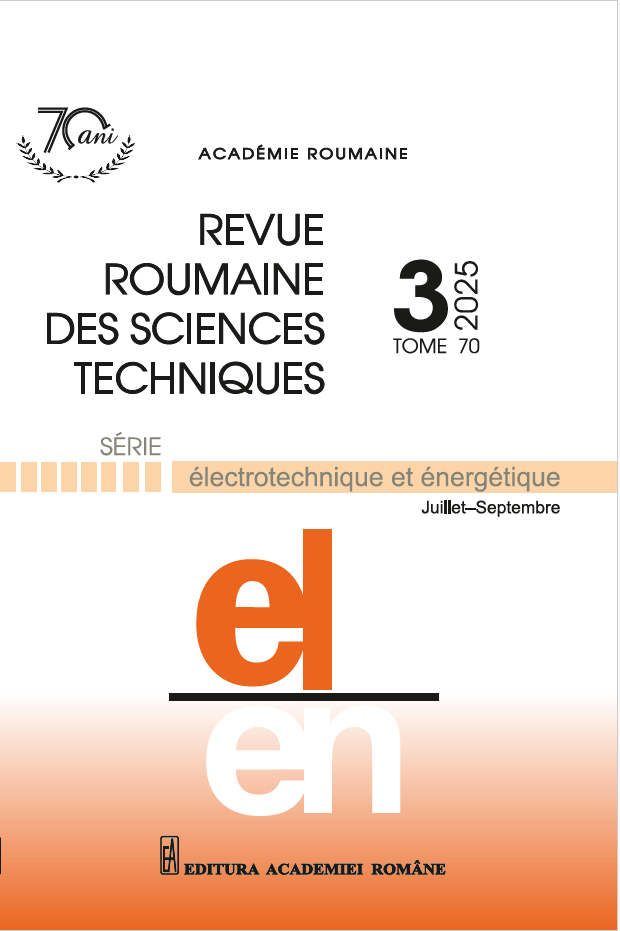MODÉLISATION DE L'ALBÉDO POUR LES USV ALIMENTÉS PAR DES SOURCES RENOUVELABLES DANS DES CONDITIONS HYDROMÉTEOROLOGIQUES VARIABLES
DOI :
https://doi.org/10.59277/RRST-EE.2025.3.10Mots-clés :
Véhicules de surface sans pilote (USV), Cellule photovoltaïque, Simulation LabVIEW, Vitesse du vent, Hauteur des vaguesRésumé
Cette étude présente un modèle mathématique innovant développé pour calculer l'albédo en fonction de la hauteur des vagues et de la vitesse du vent, deux paramètres critiques qui améliorent l'efficacité des panneaux photovoltaïques utilisés par les véhicules de surface sans pilote (USV) dans des conditions hydrométéorologiques dynamiques. L'albédo, défini comme la proportion d'énergie réfléchie par une surface, a un impact significatif sur la conversion du rayonnement solaire en énergie électrique. Le modèle proposé a été validé par des simulations et des mesures expérimentales à l'aide des outils LabVIEW et DIAdem, démontrant une précision de 96 % en conditions réelles. Ces résultats confirment l'efficacité du modèle pour prévoir la production d'énergie et optimiser la gestion de l'énergie pour les opérations maritimes autonomes.
Références
(1) X. Zhao, C. Liu, J. Zhao, Adaptive sliding mode-based fault-tolerant tracking control of multi-USV systems, 34th Chinese Control and Decision Conference (CCDC), pp. 5980–5985 (2022).
(2) S. Song, X. Guo, F. Xu, Z. Wang, Y. Xie, Y. Wu, Research on modeling of USV swarm target defense mission system from DoDAF operational viewpoint, IEEE International Conference on Unmanned Systems, ICUS 2021, pp. 214–218 (2021).
(3) M. Sundaram Ulaganathan, R. Muniraj, R. Vijayanand, D. Devaraj, Novel solar photovoltaic emulation for validating the maximum power point algorithm and power converter, Rev. Roum. Sci. Techn. – Électrotechn. et Énerg., 68 (2023).
(4) L. Leo, K. Murali, K. Chitra, K. Raju, Unmanned autonomous surface vehicle for the shallow water bathymetry applications, Oceans Conference Record (IEEE) (2022).
(5) J. Wang, J. Wang, Z.Y. Liu, X.F. Liang, H. Yi, Design and experiments of a sustainable hybrid power unmanned surface vehicle for maritime patrol, Oceans Conference Record (IEEE) (2022).
(6) S. Mahmoud Zadeh, A. Yazdani, A cooperative fault-tolerant mission planner system for unmanned surface vehicles in ocean sensor network monitoring and inspection, IEEE Trans. Veh. Technol., 72, 1, pp. 1101–1115 (2023).
(7) P. Fuke, S. De, N. Shiradkar, A. Kottantharayil, Effect of soiling on the PV module temperature and soiling loss estimation, Conference Record of the IEEE Photovoltaic Specialists Conference, pp. 1328–1331 (2024).
(8) N.-S. Popa, M.-G. Manea, C. Popa, V. Mocanu, H. Isac, M.-O. Popescu, Solar energy utilization for powering surface drones: Study on mathematical models for electricity production prediction, U.P.B. Sci. Bull., Series C, 86 (2024).
(9) V.G. Dogaru, F.D. Dogaru, V. Năvrăpescu, L.M. Constantinescu, From the photovoltaic effect to a low voltage photovoltaic grid challenge – A review, Rev. Roum. Sci. Techn. – Électrotechn. et Énerg., 69, 3, pp. 263–268 (2024).
(10) B. Hadmer, A. Kouzou, L. Chrifi-Alaoui, Voltage sensorless control of five-level packed U-cell inverter based on Lyapunov approach for grid-connected photovoltaic system, Rev. Roum. Sci. Techn. – Électrotechn. et Énerg., 69 (2024).
(11) M.-A. Ilie, D. Floricău, Grid-connected photovoltaic systems with multilevel converters-modeling and analysis, Rev. Roum. Sci. Techn. – Électrotechn. et Énerg., 68, 1, pp. 77–83 (2023).
(12) W. Yang, B. Wang, W. Ke, S. Shen, X. Wu, Research on photovoltaic power generation characteristics of small ocean observation unmanned surface vehicles, Energies (Basel), 17, 15 (2024).
(13) S. Seba, M. Birane, K. Benmouiza, A comparative analysis of boost converter topologies for photovoltaic systems using maximum power point (P&O) and beta methods under partial shading, Rev. Roum. Sci. Techn. – Électrotechn. et Énerg., 68 (2023).
(14) M. Burlacu, V. Navarapescu, A.I. Chirila, I.D. Deaconu, Optimal reactive power management for microgrids based on photovoltaic inverters using sine-cosine algorithm, Rev. Roum. Sci. Techn. – Électrotechn. et Énerg., 67, 2, pp. 117–122 (2022).
(15) X. Hu, Z. Du, F. Wang, Research on detection method of photovoltaic cell surface dirt based on image processing technology, Sci. Rep., 14, 1 (2024).
(16) Q. Lv, Z. Zournal, J. Li, P. Gao, Time-scale-based analysis of off-site and on-site albedo of a photovoltaic power plant, 7th International Conference on Smart Grid and Smart Cities, ICSGSC, pp. 507–511 (2023).
(17) A. Laib, F. Krim, B. Talbi, H. Feroura, A. Belaout, Hardware implementation of fuzzy maximum power point tracking through sliding mode current control for photovoltaic systems, Rev. Roum. Sci. Techn. – Électrotechn. et Énerg., 66, 2, pp. 91–96 (2021).
(18) J.F.P. Fernandes, et al, Extended-range marine unmanned surface vehicles for border surveillance missions, IEEE 22nd Mediterranean Electrotechnical Conference, MELECON, pp. 960–965 (2024).
(19) V. Lara-Fanego, C.A. Gueymard, J.A. Ruiz-Arias, T. Cebecauer, J. Betak, Extensive evaluation and uncertainty estimation of albedo data sources, Conference Record of the IEEE Photovoltaic Specialists Conference, pp. 945–947 (2022).
(20) C. Pike, D. Riley, L. Burnham, A model to predict daily snow albedo change over time, Conference Record of the IEEE Photovoltaic Specialists Conference, pp. 205–207 (2022).
(21) ***LabVIEW Overview - NI (2025).
(22) P. Feng, et al, Effect of thermal cycling aging photovoltaic ribbon on the electrical performance of photovoltaic modules, IEEE J. Photovolt., 14, 1, pp. 149–159 (2024).
(23) M.K. Da Silva, K.B. De Melo, T.S. Costa, D.I. Narvez, D. De Bastos Mesquita, M.G. Villalva, Comparative study of sky diffuse irradiance models applied to photovoltaic systems, SEST - 2nd International Conference on Smart Energy Systems and Technologies (2019).
(24) ***What is DIAdem? Software for measurement data processing - NI (2025).
(25) ***USB-6002 - NI (2025).
Téléchargements
Publiée
Numéro
Rubrique
Licence
(c) Copyright REVUE ROUMAINE DES SCIENCES TECHNIQUES — SÉRIE ÉLECTROTECHNIQUE ET ÉNERGÉTIQUE 2025

Ce travail est disponible sous licence Creative Commons Attribution - Pas d'Utilisation Commerciale - Pas de Modification 4.0 International.


